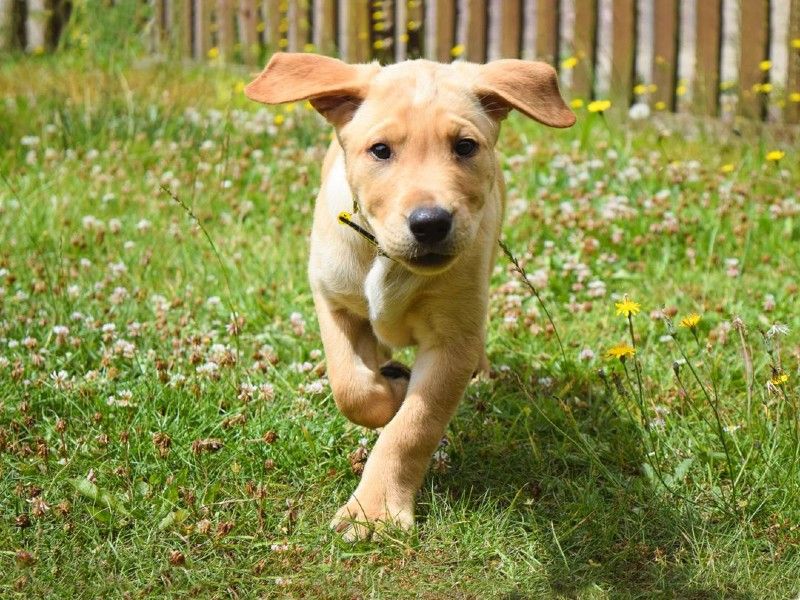Introducing your puppy to the world around them
Find out exactly what puppy socialisation is as well as when and how to do it.

You’ve just welcomed a new puppy into your home and have heard that you need to socialise them. But do you know what that means or what it involves?
Here’s everything you need to know to ensure your pooch is properly socialised as a youngster. This will help enable them to grow into a calm and confident dog.
What is puppy socialisation?
The first four months of a puppy’s life are vital. This socialisation window is when they are learning about ‘normal life’ - working out what to make of all the new people they meet and things they experience.
During this time, puppies need to be carefully introduced to a range of people, dogs, noises, objects and experiences. That way they will accept these as normal. This will give them the best chance of coping well and feeling confident in various situations as they get older.
However, the introduction of new experiences needs to be gradual and controlled. It must also be done when your puppy is relaxed. It’s vital that puppies learn about everyday life in a positive way.
Is your puppy showing high levels of arousal? Have you seen signs that they’re becoming worried or frightened? If so, it’s important that you stop the interaction or activity straight away.
Puppies that are overwhelmed or have negative experiences during this early period of life are more likely to be worried and develop behaviour problems as an adult.
Problems can also arise where these early experiences don’t match what happens as they get older. Dogs are more likely to worry about things that they didn't come across when they were young.
When to socialise your puppy
You should start to socialise your puppy as soon as they join your family. But this must begin in the home.
It is important that puppies don’t go out walking in public before they are fully vaccinated, as certain potentially serious diseases can be picked up from the environment and other dogs if your puppy does not have immunity to these diseases through vaccination. Speak to your vet about how long your pup needs to wait after vaccination before going outside. Your dog should also start an anti-parasite regime before going outside. Again, speak to your vet for advice on what’s most suitable for your individual dog.
Puppies can, however, be carried outside - perhaps in a carrier or sling - so you can begin to introduce them to the world around them. This will enable you to begin the socialisation process without them going on the ground. Then, once they can venture out on their own four paws, you can continue to give them new experiences further from home.
How to socialise your puppy
You may want to create a puppy socialisation checklist. That way you can make sure you have covered everything that’s required. Here’s what needs to be on it.
Meet a variety of other dogs
Once your puppy is fully vaccinated, you can begin taking them out on their first walks and introducing them to other dogs. Your pup will need to meet dogs of all ages, shapes and sizes.
Observing other animals such as cats and horses
It’s not only other dogs that your pup needs to meet, but a wide range of other animals too, including cats, horses and fam animals. So, make sure they are introduced to them early on. As with other dogs, this should be done from a safe distance and make sure you reward them for calm behaviour. That way they will know it’s nothing to fear and will feel comfortable around them.
Make sure you don’t scare the other animals either or make them feel cornered in order to socialise your pup. They should feel calm and confident too. To get your pup used to farm animals and horses, walk past fields where they’re held fairly regularly. For cats, this can be done on a more ad hoc basis, as and when you happen to walk past one. If you have a cat in your home, find out how to properly introduce your dog to them.
Get your puppy used to being handled
As well as handling your pet yourself, you’ll also need to ensure your dog is used to being handled by others such as vets and groomers. They will be picked up, have their paws cleaned, ears examined, nails cut and coats groomed – to name just a few. So make sure you start getting them used to being handled early on.
Introduce your puppy to all different types of people
A big part of everyday life for dogs is meeting new people, when out on walks or when visitors come to their home.
You can start to prepare your pup for visitors by getting them used to the doorbell. Teach them to go to their bed or another room when it rings. Once they get good at this, you can begin to welcome guests to your home.
You want to make sure you are introducing your puppy to people of all ages, backgrounds and walks of life. Before heading out with them to do this, you could use props around the home, such as different outfits. Get into a big hat or a wig. Introduce things like walking sticks, umbrellas, rucksacks or high-vis clothing if you have them.
This will broaden your puppy’s experiences and get them used to items they might see when they do go out. Make sure this is a positive experience for your puppy by giving them something enjoyable to do. As long as they are relaxed and happy, give them a treat or a toy to play with.
It’s very important not to scare your puppy, so take things slowly. Stop if your puppy starts to look worried or moves away.
Prepare them for new sounds
It’s important to slowly and carefully introduce your puppy to sounds that they are likely to hear in everyday life, including fireworks. Puppies that are gradually exposed to noises during early life are more likely to cope with unusual sounds later. The best way to do this is with Sound Therapy recordings.
Introduce them to new environments and objects
Puppies will encounter lots of objects and experiences that they need to see as normal. This will enable them to grow into confident adults.
Introduce them to:
- Different surfaces to walk on, to help your puppy feel various textures under their paws.
- Objects they might see when they leave the house.
- Everyday items such as umbrellas, bicycles, suitcases, wheelchairs and buggies.
- Smells around your home. But don’t place these near your dog’s bed or food and water bowls.
- Your vacuum cleaner or hairdryer. Do this while it's switched off at first. Then switch it on. Once your pup is calm with this, start to move it around, first with the sound off and then on.
- Your car on the driveway. Get them comfortable with climbing in and out, wearing a safety harness, and the sound of the engine starting.
Your puppy should always have a positive experience when introduced to new things. Make sure you do it gradually and reward them each time.
Help them to start spending time alone
It’s normal for puppies to feel worried about being alone. Dogs are social animals after all. But it’s vital that your puppy feels relaxed and confident to be left by themselves.
If they don’t learn this, they're more likely to develop separation anxiety. This might result in unwelcome behaviours when they’re home alone, such as barking or destruction.
To avoid this, you need to get them comfortable with spending time alone.
As well as socialising your pup, it’s important to start reward-based training with them as soon as you can. This will help prevent unwanted behaviours from developing. Our training hub is here to help get you started.




